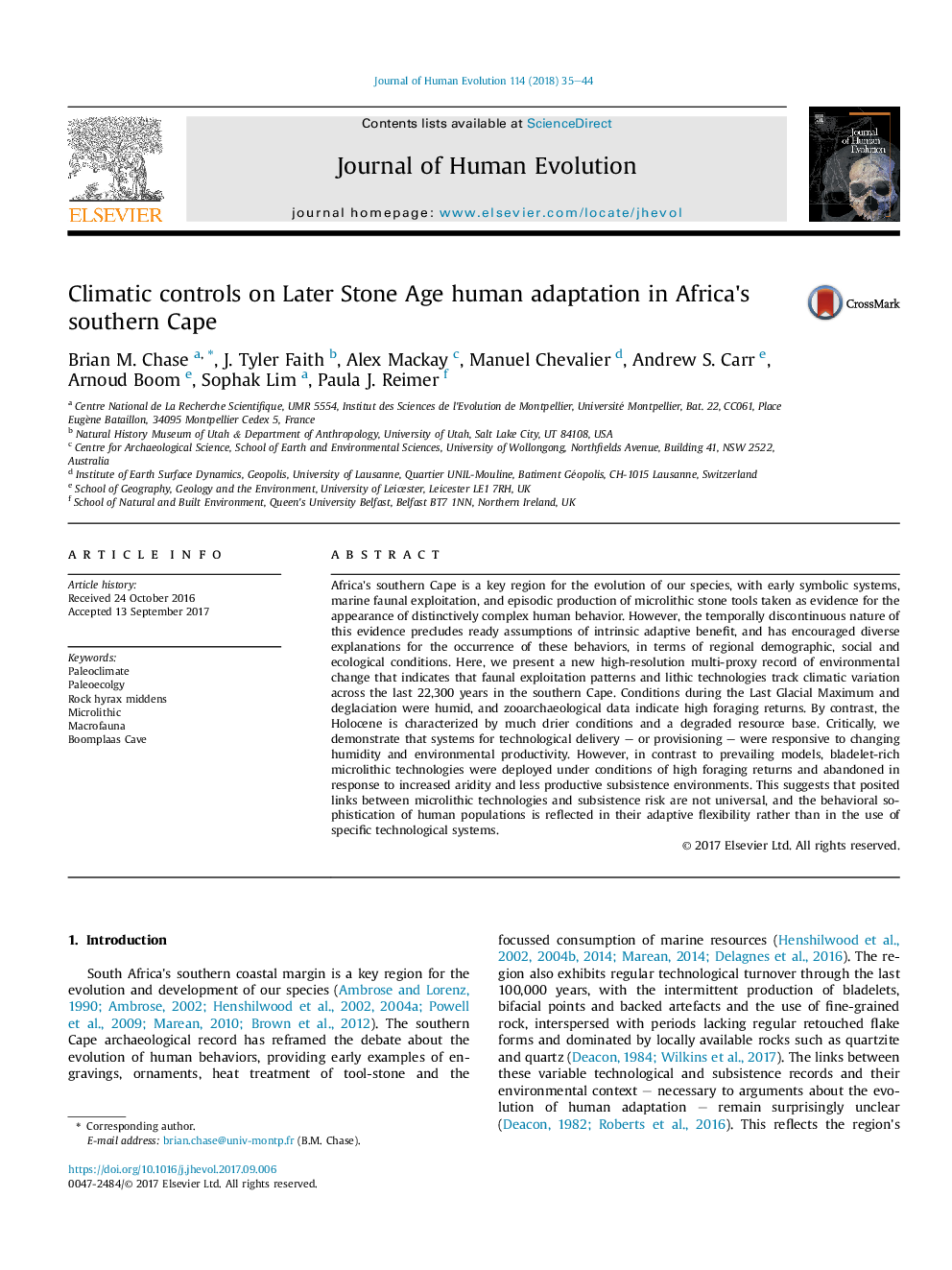| کد مقاله | کد نشریه | سال انتشار | مقاله انگلیسی | نسخه تمام متن |
|---|---|---|---|---|
| 8887333 | 1628135 | 2018 | 10 صفحه PDF | دانلود رایگان |
عنوان انگلیسی مقاله ISI
Climatic controls on Later Stone Age human adaptation in Africa's southern Cape
ترجمه فارسی عنوان
کنترل آب و هوا بر انطباق انسان انسانی بعدا در قصر جنوبی
دانلود مقاله + سفارش ترجمه
دانلود مقاله ISI انگلیسی
رایگان برای ایرانیان
ترجمه چکیده
کیپ جنوبی آفریقا یک منطقه کلیدی برای تکامل گونه های ما است، با سیستم های نمادین زودهنگام، بهره برداری از فون های دریایی و تولید اپیزودهای ابزار سنگی میکرولیتیک که به عنوان شواهدی برای ظهور رفتارهای پیچیده انسان شناخته شده است. با این حال ماهیت دائمی وقفه این شواهد مانع آمادگی پیشنهادی برای منافع انطباق درونی شده است و توضیحات گوناگونی برای وقوع این رفتارها را از لحاظ شرایط جمعیتی، اجتماعی و محیطی منطقه ای تشویق کرده است. در اینجا، ما یک رکورد جدید چند پروکسی با کیفیت بالا در تغییرات زیست محیطی را نشان می دهیم که نشان می دهد الگوهای استثمار فون و تکنولوژی های لیفتینگ، تغییرات اقلیمی را در طی 22،300 سال گذشته در کیپ جنوبی به دست می آورند. شرایط در طول حداکثر حداکثر و انهدام یخبندان آخرین رطوبت بوده و داده های زیست شناختی نشان می دهد که بازگشت مواد غذایی بالا است. در مقابل، هولوسن با شرایط بسیار خشک و پایه منابع تخریب شده مشخص می شود. از لحاظ انتقادی، ما نشان می دهیم که سیستم های تحویل تکنولوژی - یا تامین کننده - به تغییر رطوبت و بهره وری محیطی واکنش نشان می دهند. با این حال، در مقایسه با مدل های غالب، تکنولوژی های میکرولیتیک غنی از تراشه های غول پیکر در شرایط بازده بالا بود و در واکنش به افزایش خلوص و محیط زیست کمتری تولید شد. این نشان می دهد که ارتباطات مستقیمی بین تکنولوژی های میکرولیتی و ریسک های تمیز بودن جهانی نیستند و پیچیدگی رفتاری جمعیت های انسانی در انعطاف پذیری انطباقیشان، نه در استفاده از سیستم های تکنولوژیکی خاص، منعکس می شود.
موضوعات مرتبط
علوم زیستی و بیوفناوری
علوم کشاورزی و بیولوژیک
بوم شناسی، تکامل، رفتار و سامانه شناسی
چکیده انگلیسی
Africa's southern Cape is a key region for the evolution of our species, with early symbolic systems, marine faunal exploitation, and episodic production of microlithic stone tools taken as evidence for the appearance of distinctively complex human behavior. However, the temporally discontinuous nature of this evidence precludes ready assumptions of intrinsic adaptive benefit, and has encouraged diverse explanations for the occurrence of these behaviors, in terms of regional demographic, social and ecological conditions. Here, we present a new high-resolution multi-proxy record of environmental change that indicates that faunal exploitation patterns and lithic technologies track climatic variation across the last 22,300 years in the southern Cape. Conditions during the Last Glacial Maximum and deglaciation were humid, and zooarchaeological data indicate high foraging returns. By contrast, the Holocene is characterized by much drier conditions and a degraded resource base. Critically, we demonstrate that systems for technological delivery - or provisioning - were responsive to changing humidity and environmental productivity. However, in contrast to prevailing models, bladelet-rich microlithic technologies were deployed under conditions of high foraging returns and abandoned in response to increased aridity and less productive subsistence environments. This suggests that posited links between microlithic technologies and subsistence risk are not universal, and the behavioral sophistication of human populations is reflected in their adaptive flexibility rather than in the use of specific technological systems.
ناشر
Database: Elsevier - ScienceDirect (ساینس دایرکت)
Journal: Journal of Human Evolution - Volume 114, January 2018, Pages 35-44
Journal: Journal of Human Evolution - Volume 114, January 2018, Pages 35-44
نویسندگان
Brian M. Chase, J. Tyler Faith, Alex Mackay, Manuel Chevalier, Andrew S. Carr, Arnoud Boom, Sophak Lim, Paula J. Reimer,
